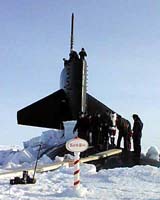| . |  |
. |
 Aberdeen - November 30, 1999 - The ocean currents that give Europe its mild climate are changing. Scientists have found evidence that global warming may cause a big freeze by switching off a current called the North Atlantic Drift.
Aberdeen - November 30, 1999 - The ocean currents that give Europe its mild climate are changing. Scientists have found evidence that global warming may cause a big freeze by switching off a current called the North Atlantic Drift.
Several teams have found signs that the current, which brings warm water to northwest Europe from the Gulf Stream, is being disrupted by a growing amount of freshwater entering the Arctic Ocean. This increase is a result of changes attributed to global warming: melting ice, increased rainfall and changing wind patterns. The North Atlantic Drift is part of a global conveyor belt that brings warm surface water from the Gulf of Mexico to northwest Europe and sends cold deep water back. The belt is driven by two "pumps", one in the Greenland Sea and one in the Labrador Sea, where the surface water cools, sinks and then returns south. A computer model developed by Stefan Rahmstorf of the Potsdam Institute for Climate Impact Research in Germany and his colleagues suggests that global warming could turn off the North Atlantic Drift, causing temperatures in northwest Europe to drop by 5 �C or more (New Scientist, 8 February 1997, p 26). However, there has been no evidence that this is really happening. But now Bill Turrell, leader of the Ocean Climate Group at the Scottish Executive's Marine Laboratory in Aberdeen, has found evidence that fits in with Rahmstorf's predictions. He analysed more than 17 000 measurements of seawater salinity between Shetland and the Faroe Islands since 1893. Turrell found that in each of the past two decades the salinity of the deep water flowing south has dropped by 0.01 grams of salt per kilogram of seawater. So its density has probably also decreased by 0.01 kilograms per cubic metre per decade. "This is the largest change we have seen in the outflow in the last 100 years," says Turrell. "It is consistent with models showing the stopping of the pump and the conveyor belt." In the 1950s the salinity of the outflow was so stable it was used to calibrate equipment. His findings are echoed by work at the Fisheries Laboratory of the Faroes. Monitoring there suggests the deep water outflow through the channel southwest of the islands is getting warmer. In a study yet to be published, Bogi Hansen of the lab says the level at which water is at �0.5 �C dropped by 60 metres between 1988 and 1997. Svein �sterhus of the University of Bergen in Norway has also discovered that a deep-sea current closer to the Arctic has gone into reverse. In 1982 and 1983, deep water flowed southwards from the Greenland Sea into the Norwegian Sea at 10 centimetres per second. But in 1992 and 1993, the water was flowing at 1 centimetre per second in the opposite direction. This indicates that the Greenland Sea pump "has been dramatically reduced in power", says �sterhus. "Any evidence that changes in ocean currents are starting to occur is very important," says Rahmstorf. "The freshening and warming of the deep water flowing back into the Atlantic is consistent with global warming but could also have natural causes.
This article will appear in the November 20 issue of New Scientist New Scientist. Copyright 1999 - All rights reserved. The material on this page is provided by New Scientist and may not be published, broadcast, rewritten or redistributed without written authorization from New Scientist.
TERRADAILY.COM
|
| |||||||||
| The content herein, unless otherwise known to be public domain, are Copyright 1995-2016 - Space Media Network. All websites are published in Australia and are solely subject to Australian law and governed by Fair Use principals for news reporting and research purposes. AFP, UPI and IANS news wire stories are copyright Agence France-Presse, United Press International and Indo-Asia News Service. ESA news reports are copyright European Space Agency. All NASA sourced material is public domain. Additional copyrights may apply in whole or part to other bona fide parties. Advertising does not imply endorsement, agreement or approval of any opinions, statements or information provided by Space Media Network on any Web page published or hosted by Space Media Network. Privacy Statement All images and articles appearing on Space Media Network have been edited or digitally altered in some way. Any requests to remove copyright material will be acted upon in a timely and appropriate manner. Any attempt to extort money from Space Media Network will be ignored and reported to Australian Law Enforcement Agencies as a potential case of financial fraud involving the use of a telephonic carriage device or postal service. |